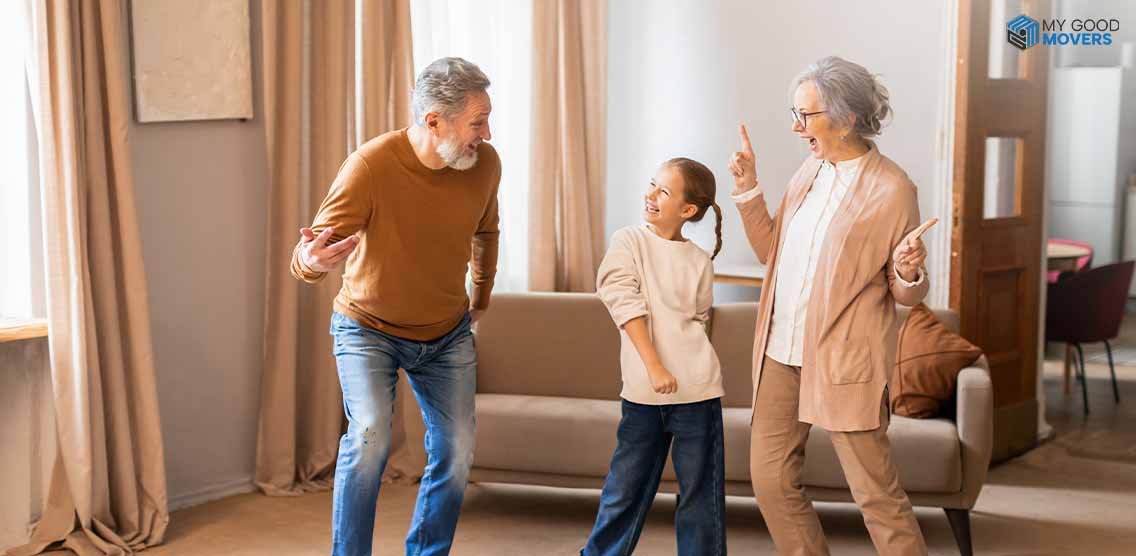Family is not an important thing, it’s everything.
This saying of Michael J. Fox is well-known in many families today, where an increasing number of elderly parents are moving in with their adult children.
Because people are living longer, more families have been faced with the crucial choice of what is best for aging parents.
A study found that more than 57 million Americans were over the age of 65 and believed that this figure could reach as high as 82 million by 2050.
With surging healthcare costs and a growing desire to keep families in the comfort of their own homes, more households are taking in elderly relatives.
But the reality is, choosing to bring an elderly parent into your home is more than about moving; it's also about love and care and, yes, some responsibility.
For some, it is a method to re-pay the parenting that was done to them. For others, it's a solution to manage the high costs of long-term care facilities, which can range from $4,500 to $6,000 per month.
Putting financial concerns aside, this arrangement also gets into more enriching family relationships as the elderly are inclined to be less isolated compared to when they live alone.
But the rewards bring their own set of challenges. What can you do to ante up and prepare your house for a senior parent? How will this affect family cohesion and emotional well-being?
These are just a few of the questions that families must think of as they negotiate this transition.
Trend Older Adults Moving in With Family
More adults are living with adult children or other relatives because of that demographic shift.
Curious about your moving costs? Fill out the details, and we’ll calculate them for you.

With soaring healthcare costs, housing affordability problems, and a broad push for people to age in place instead of at expensive nursing homes, the ranks of older adults living with family members have grown sharply in recent years.
Of the adults who are residing in another person's home, AARP says 14 percent are aging parents. The focus of this type of decision quite often favors the older generations who are able to remain at their place and experience relational support —a significant factor in the fight against loneliness.
It is more than economics; family caring has cultural and emotional roots to help nourish the most powerful gene pool across generations.
Prepare Home for Elderly Family Members
Preparing Your Home for Elderly Family Members is One Of the First Steps in Facilitating The Elderly Moving in With Family
You may need to make a few changes to maintain safety and access based on the health and mobility of your loved one.
Practical modifications such as placing grab bars in bathrooms, anchoring rugs, or even establishing a first-floor bedroom. If you are meeting with an in-home caregiver, make sure to survey the home for homes that have staircases and may need stairlifts or ramps.
In addition to physical changes, think about how your home and family will adjust to the added role of caregiving. This includes: getting ready financially and emotionally as many caregivers provide an average of 26 hours per week in caring for their elderly parents.
Having a welcoming, distinctly separate space for your seniors to call their own is crucial for preserving dignity and saving stress down the road.
Emotional and Financial Costs
Bringing an elderly parent to stay in the family home is a large emotional upheaval. The reward could be significant — more of a connection, time together, and less worried that they are safe.
However, it's important to recognize that this change can cause stress, particularly if a child becomes the primary caregiver.
Research shows that 59% of adults aged 65 and older live with a spouse or partner, but many living alone experience negative mental health outcomes, including loneliness and depressive symptoms.
If they move in with family members, the heartache associated with these memories is lessened, but there is now a higher level of caregiver strain. Family dynamics can change, and this is why it is important to keep communication open to avoid burnout.
This move could help principalities from the several thousand monthly costs of nursing homes or assisted living facilities. However, many families have had to pay for home modifications, medical supplies and lost income if a family member cuts back on work hours to provide care.
Tips for Moving With Elderly Parent
What you need to do — other than plan (both logistically and emotionally) the move itself. The less-than-surprising first piece of advice for moving an elderly parent is to include your aging loved one in the decision.
Giving them a little bit of control can reduce their anxiety and help them adapt to the new living situation. Techniques that could hopefully ease the moving process are:
Start by simplifying the space they are living in as much as possible, paying particular attention to sentimental things they wish to keep on hand.
Fill your home with furniture, photos, and décor that reminds you of your favorite spaces.
Have family negotiations to ensure that each person knows what is expected of them relative to daily care, financial participation, and household roles.
Take Care Of Your Aging Parents At Home
Providing care for aging parents who are already in your home will require thoughtful planning due to their changing needs. Your loved one may need more and more care, especially if he or she has other health issues, such as arthritis, diabetes, or dementia.
According to a Guardian Study, under half a million caregivers now spend up to 30 hours per week on tasks including medication administration, time for physical therapy, and personal care .
You need a timetable that will help you balance work and family responsibilities. This could require hiring a part-time aide, utilizing adult daycare centers, or arranging for respite care to avert caregiver burnout.
Moving In with Family and Tips for Helping Your Elderly Parents
Check out ways to help the move be as flawless as possible; here are three things that assist you to move elderly parents in with family:
Open up about housework, pet care and "you time," so there will be no disagreements once you are together for long periods.
Have regular visits from friends and family to provide support. Caring for elderly family members is a group project.
As your parents age and their needs change, keep an open mind about adjusting the type of care you provide, for example, bringing in professionals or exploring long-term care.
If one caregiver has physical and emotional health issues. Reach out to local organizations that are committed to supporting caregivers or online caregiver support groups or get professional mental health counseling.
Family Caregivers In The U.S.
Family caregivers are essential to the health and well-being of older adults in America. Right now, 41 million people provide unpaid care to an elderly family member.
And that's an emotional and financial commitment, but it is also the best kind of societal good.
Nursing homes and assisted living facilities would be unable to meet demand without family caregivers.
Since the U.S. population is rapidly aging, family-based caregiving will be needed more than ever in the coming years.
As a result, many states have responded by enacting resources that are targeted at caregivers, such as tax credits, paid family leave policies and caregiver support programs.





